Bassil Dahiyat has been Xencor’s president and chief executive officer since the company’s incorporation in August 1997. He is a co-founder of Xencor and co-inventor of Xencor’s breakthrough XmAb® technology. He holds a PhD in chemistry from Caltech, and BS and MSE degrees in biomedical engineering from the Johns Hopkins University. He has co-authored numerous scientific papers in the fields of protein design and drug delivery, is an inventor of more than 30 U.S. and numerous foreign patents, and has received scientific awards from the American Chemical Society, the Controlled Release Society, the Protein Society, and Caltech. He is an active member of the Johns Hopkins alumni volunteer community and a current member of the Johns Hopkins Leadership Fellows.
Q&A
What made you choose Johns Hopkins?
I chose Hopkins because it was one of the very few places at the time that had a biomedical engineering department, and it had invented the discipline. My decision wasn’t very well thought out; I wanted to be a biomedical engineer only because the name seemed to combine the two things that interested me, and vaguely reflected the “genetic engineering” that I’d heard about in the news being a huge new technology trend. Also important was the scholarship I was offered for 60 percent of tuition.
Do you have any memories that stand out from the classroom or from the lab?
So many memories to choose from. In the classroom, I can still see Professor Popel writing his lucid explanation of the equations for fluid flow in a tube and relating that to blood flow in vessels, and Professor Tung graphically demonstrating the cardiac dipole in Phys. Found. with a big arrow. Fantastic teachers. I basically lived in Kam Leong’s lab beginning the end of my freshman year, so rather than one memory, I remember college as just being in the lab. And that was the best training as an engineer I could have possibly had.
Do you have any advice for aspiring engineers?
Take as broad a science and engineering curriculum in college as you can, and go as deep as you can into multiple subjects because you will never get the opportunity to spend time on the foundational knowledge like you do in college. I refer back to that knowledge all the time, especially as my career has evolved in different technical directions. And start working right away, whether in a lab or internships at companies, because the real world comes at you fast.
Where are you working now? How did get involved in this line of work?
I work at Xencor, a clinical stage biotechnology company that engineers proteins, specifically antibodies and immune signaling proteins called cytokines, to treat cancer and autoimmune diseases. I helped start the company in 1997 as a spinout of my PhD work at Caltech doing protein design. The technology very rapidly diverged from the Caltech tools, and we have become a company that engineers molecules that themselves engineer immune responses to treat disease. We do this by engineering small changes in the structure of an antibody, resulting in either new biological mechanisms of therapeutic action or dramatically enhanced pharmaceutic properties, for example, making them more or less potent, potentially safer, or longer lasting—all with the goal of improving patient outcomes and quality of life. Along with our pharmaceutical partners, about a dozen molecules engineered with Xencor technology are currently being tested in clinical studies, and one recently received regulatory approval for marketing in the United States.
Why do you choose to stay connected to and volunteer your time for Johns Hopkins as an alumnus?
Hopkins set my life on the course it is on and taught me how to do research and engineering. I’ve become more involved at Hopkins because I want to help the university provide that sort of opportunity to other students.

